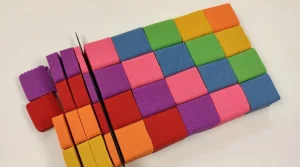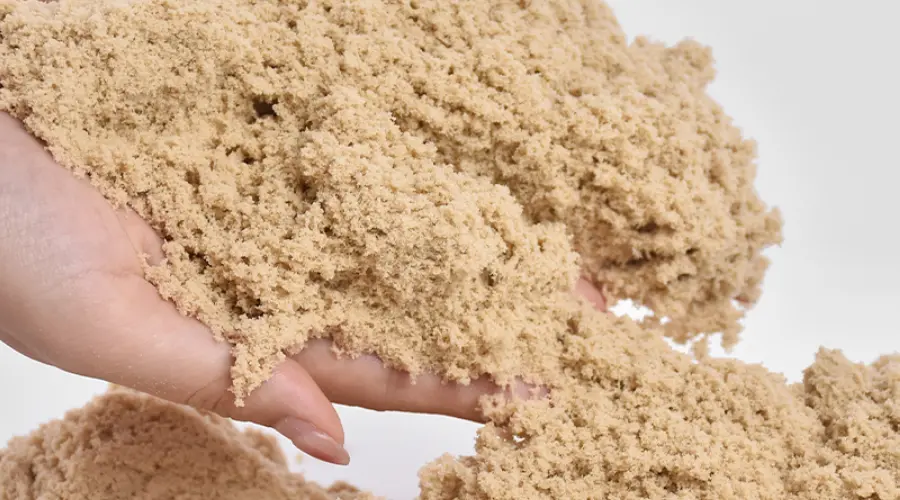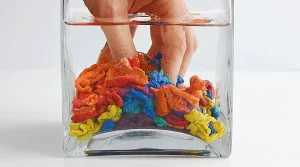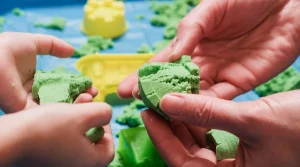
What Is So Special About Kinetic Sand? The Fascinating Science
Discover what makes kinetic sand so special — from its unique texture to the fascinating science behind its magical movement.
#1 Toys Manufacturer in China. WhatsApp: +86 180-0088-4063. Email: [email protected]
#1 Toys Manufacturer in China. WhatsApp: +86 180-0088-4063. Email: [email protected]

Sensory sand is more than a simple play material. It is carefully designed to provide a consistent texture, safe handling, and engaging tactile experiences. Children interact with it naturally, discovering patterns, textures, and subtle differences in resistance.
Unlike ordinary sand, sensory sand is engineered to be moldable, soft, and safe for repeated indoor use. Its controlled properties allow children to explore freely without hazards, offering a unique medium that encourages experimentation and observation.
Sensory sand differs from regular sand in texture, consistency, and safety. Its fine particles are often mixed with non-toxic binders to create a pliable, cohesive material that holds shapes but flows easily under pressure.
This unique combination allows children to manipulate it in ways that ordinary sand cannot. They can roll, squeeze, or mold it repeatedly without it drying out or scattering, providing a controlled, engaging medium for exploration and learning.
Children approach sensory sand with curiosity and imagination. Some press and flatten it, others dig tunnels or shape small forms. These interactions are spontaneous and self-directed, reflecting natural exploratory behavior.
As they explore, children often test cause and effect, noticing how the sand responds to pressure, motion, and tools. This repeated experimentation helps them develop tactile awareness and fine motor coordination in an intuitive, hands-on manner.
Sensory sand can complement early childhood learning by introducing basic concepts of texture, volume, and spatial relationships. Even simple play with sand engages observation, experimentation, and problem-solving skills.
Children often combine tactile experiences with imaginative scenarios. They may build miniature worlds or structures, linking hands-on manipulation to early cognitive development. Sensory sand thus becomes both a playful material and a subtle educational tool.
Sensory sand is carefully formulated to provide a consistent, safe, and engaging play experience. Unlike natural beach sand, its ingredients are selected to create specific textures, durability, and tactile responsiveness. Children can manipulate it without risk while exploring its unique properties.
The base of sensory sand often consists of fine, smooth mineral particles, such as silica or quartz. These tiny grains provide the soft, consistent texture that distinguishes sensory sand from ordinary sand. Their uniformity prevents sharp edges and ensures safe, repeated handling.
Children can dig, pour, or mold these particles without discomfort. The tactile feedback helps refine touch perception, hand-eye coordination, and early motor skills. The mineral base also allows the sand to hold shapes while still flowing naturally, making exploration more engaging.
Non-toxic binders are added to sensory sand to make it cohesive and moldable. These ingredients allow the sand to stick lightly, hold forms, and resist crumbling, enhancing its usability for indoor play and repeated use.
Additives may also improve durability and moisture retention, keeping the sand soft and pliable over time. These safe compounds ensure that children can experiment freely, stretching, pressing, or forming shapes without the material breaking apart or drying too quickly.
Colorants and mild scents are often added to sensory sand to make it visually appealing and stimulating. Soft pigments and natural dyes create vibrant colors without compromising safety, while subtle scents enhance sensory engagement.
Texture modifiers, such as tiny polymer particles, can be included to adjust smoothness, flow, and cohesion. These variations allow children to experience different tactile sensations, compare textures, and develop sensory awareness, all while keeping play safe and enjoyable.
Sensory sand is designed specifically for safe, controlled play, making it distinct from ordinary sand found at beaches or playgrounds. Its composition, texture, and performance are tailored to indoor exploration and repeated handling. Children can enjoy it without the hazards of sharp particles or inconsistent grain sizes.
Unlike natural sand, sensory sand maintains a uniform feel and predictable behavior. This controlled consistency allows caregivers and educators to create structured learning experiences while preserving the tactile freedom that makes sand play engaging.
One of the primary differences between sensory sand and regular sand is safety. Ordinary sand can contain debris, sharp fragments, or contaminants, which are unsafe for young children. Sensory sand uses fine, smooth particles to eliminate these risks.
The texture is soft, pliable, and consistent, allowing children to dig, mold, and squeeze without irritation. Its tactile feedback is predictable, supporting sensory exploration while preventing discomfort or accidental injury during indoor play.
Sensory sand flows smoothly yet holds shapes when pressed, creating a balance between malleability and structure. Regular sand tends to scatter and shift unpredictably, which can limit creative shaping or precise exploration.
This enhanced playability allows children to experiment with building, molding, or sculpting designs repeatedly. The consistent texture encourages longer, more focused play sessions, giving children opportunities to practice fine motor skills and spatial reasoning in a safe environment.
Another key distinction is durability. Sensory sand retains moisture and cohesion longer than natural sand, keeping it soft and workable over many play sessions. It is engineered to resist drying out or clumping excessively.
Its longevity means that children can revisit projects, practice the same techniques, or explore new patterns without the material degrading. This reliability enhances the educational and sensory value of sand play, making it a versatile tool for both fun and learning.
Sensory sand provides a rich tactile environment where children can explore textures, resistance, and movement. It encourages hands-on interaction, allowing children to discover how materials respond to pressure and motion while supporting natural curiosity.
Unlike more rigid toys, sensory sand offers an open-ended medium. Its moldable, flowing properties allow children to engage repeatedly in exploration, experimentation, and creative manipulation, supporting both sensory and cognitive development.
Sensory sand delivers multi-layered tactile feedback. Children feel differences in texture, firmness, and flow as they press, scoop, or smooth the sand. This continuous sensory input helps refine touch perception and heightens awareness of subtle differences in pressure and resistance.
Repeated interaction with sensory sand trains the nervous system to process tactile information more efficiently. Children learn to gauge force, manipulate objects precisely, and understand how their hands and fingers affect the material, forming foundational skills for daily tasks.
Manipulating sensory sand strengthens small muscles in the hands and fingers. Rolling, pressing, and shaping the sand requires coordinated movements, improving dexterity, grip, and hand-eye coordination.
Activities like forming shapes, digging tunnels, or building small structures encourage repeated fine motor practice. Over time, these experiences translate into better control for tasks like writing, cutting, or buttoning clothes, all through engaging, hands-on play.
Playing with sensory sand naturally promotes focus. Children must concentrate on movements, pressure, and patterns, which encourages attention to detail and sustained engagement.
This focused play also supports mindfulness. Observing how sand flows, molds, or collapses draws children into the present moment. The repetitive, rhythmic actions—scooping, smoothing, shaping—create a calming effect, making sensory sand a subtle tool for emotional regulation and concentration.
Sensory sand is not only tactile—it also engages the mind. Children learn through experimentation, trial-and-error, and imaginative play. The material offers endless possibilities for creating shapes, structures, and stories, fostering both cognitive and creative growth.
By interacting with sensory sand, children naturally practice planning, problem-solving, and spatial reasoning. They explore relationships between objects, test ideas, and adjust their strategies in real time, combining play with subtle learning opportunities.
When children mold and shape sensory sand, they encounter small challenges. Sand may collapse if a tower is too tall or a shape too thin. These moments encourage problem-solving, as children experiment with angles, pressure, or support to achieve desired results.
Repeated attempts help develop patience, planning, and adaptability. Each interaction teaches children to evaluate outcomes and make adjustments, reinforcing early executive function skills while keeping the play experience fun and engaging.
Sensory sand invites imaginative play. Children can create miniature landscapes, pretend objects, or entire worlds. They often narrate scenarios, building stories around their creations and combining tactile play with language and social skills.
This imaginative use of sensory sand helps children explore abstract thinking, sequencing, and creativity. Open-ended play encourages divergent thinking, allowing children to invent new concepts, experiment with characters, and explore narrative structures while learning through touch.
Sensory sand provides immediate feedback, making cause-and-effect relationships clear. Children learn that pressing lightly versus firmly, shaping slowly versus quickly, or combining colors results in different outcomes.
This real-time experimentation reinforces logical thinking and observational skills. By repeatedly testing actions and observing results, children develop early scientific reasoning, understanding how materials respond to forces, manipulation, and environmental changes—all while playing.
Sensory sand offers more than cognitive and motor benefits—it also supports emotional well-being. The soft, moldable texture encourages gentle, repetitive motions that can be calming and soothing for children.
This tactile medium provides a quiet, controlled environment where children can relax, focus, and release energy in a safe, engaging way. Sensory sand naturally blends play with subtle emotional support.
Manipulating sensory sand often produces a calming effect. Children pressing, rolling, or smoothing the sand experience consistent tactile feedback that can reduce restlessness or agitation.
The rhythmic, repetitive nature of these motions helps children regulate arousal levels, focus attention, and transition from active to calmer states. It’s a subtle yet effective way to introduce relaxation into play.
Sensory sand allows children to practice self-regulation. By choosing how to shape, press, or move the sand, they make decisions and control their actions in real time.
This repeated practice enhances emotional control and patience. Children learn to manage impulses and focus on tasks, developing skills that transfer to everyday routines and interactions with peers or caregivers.
Sand play provides a medium for expressing feelings indirectly. Children can create scenes, shapes, or patterns that reflect their mood, thoughts, or ideas without needing words.
By observing and interacting with sensory sand, children explore emotions in a safe, hands-on way. This expression helps them process feelings, communicate experiences, and gain insight into their own emotional states through tactile and imaginative engagement.
Sensory sand can also foster social skills when children play together. Group activities with sand encourage sharing, turn-taking, and cooperative problem-solving while maintaining a playful, hands-on environment.
The material’s open-ended nature allows multiple children to explore simultaneously, combining creativity and tactile engagement. Playing side by side encourages observation, imitation, and collaboration, promoting both social interaction and learning.
When children share sensory sand, they naturally practice patience and negotiation. Passing tools, dividing sand portions, or taking turns building shapes teaches respect for others and awareness of group dynamics.
These simple exchanges strengthen empathy and cooperation. Children learn to balance their own desires with group goals, making sand play a platform for practicing social skills in a low-pressure, engaging way.
Sensory sand play often inspires storytelling and verbal expression. Children may describe their creations, explain processes, or narrate imaginative scenarios while manipulating the sand.
This interaction builds vocabulary, sequencing skills, and conversational abilities. Sharing ideas about shapes, structures, or imaginative scenes encourages expressive language while connecting sensory experiences with words.
Working together with sensory sand allows children to combine ideas, plan constructions, and experiment with joint problem-solving. They can merge creations, create landscapes, or role-play scenarios collectively.
Collaborative creativity strengthens teamwork, flexibility, and critical thinking. Children learn to negotiate, compromise, and adapt plans while enjoying tactile exploration, blending social interaction with cognitive and sensory development.
While sensory sand is designed for safe play, following basic guidelines ensures children can explore freely without risk. Proper material selection, play area setup, and maintenance are key to maximizing safety and enjoyment.
Being mindful of these aspects also teaches children responsibility and respect for materials, encouraging independence while maintaining a secure environment for sensory and creative play.
Selecting non-toxic, child-safe sensory sand is crucial. Ingredients should be free from harmful chemicals, allergens, or sharp particles. Age-appropriate labeling helps caregivers ensure safe exploration for different developmental stages.
Safe sensory sand allows children to manipulate, mold, and press without risk, encouraging repeated, hands-on engagement. Knowing the material is safe helps caregivers and educators confidently incorporate sand into indoor play and learning activities.
A designated play area keeps sensory sand contained and reduces mess. Using trays, mats, or low tables helps define boundaries and prevents sand from spreading to floors or furniture.
Clear space also allows children to focus on tactile exploration without distraction. Adequate lighting, comfortable seating, and nearby storage for tools and containers contribute to a well-organized, safe, and enjoyable sand play environment.
After play, sensory sand should be returned to sealed containers to prevent contamination and drying. Tools, molds, and surrounding surfaces should be cleaned to maintain hygiene and prolong the sand’s usability.
Routine cleaning and storage also teach children responsibility. They learn to care for materials, organize spaces, and follow simple routines, reinforcing life skills while preserving the sensory, tactile, and educational qualities of the sand for future sessions.
Sensory sand provides rich learning opportunities, but parental guidance can enhance its value. By observing, supporting, and introducing small prompts, parents can help children explore freely while encouraging creativity and skill development.
Simple strategies make play more productive without taking away the child’s independence. Subtle guidance ensures safety, engagement, and a balance between open-ended exploration and structured learning.
One of the most effective strategies is to watch without directing. Children naturally explore sensory sand, testing textures, shapes, and cause-and-effect relationships at their own pace.
By stepping back, parents allow children to problem-solve and make decisions independently. Observing also provides insights into developmental progress, helping caregivers recognize emerging skills in fine motor control, planning, and focus.
Parents can gently prompt experimentation without giving instructions. Questions like “What happens if you press harder?” or “Can you make a new shape?” invite exploration and curiosity.
Combining sensory sand with tools, molds, or other materials encourages creative thinking. Children can experiment with different textures, combine colors, or invent miniature worlds, turning tactile play into imaginative problem-solving.
Rotating sensory sand with other tactile or sensory materials, such as kinetic sand, playdough, or small manipulatives, keeps play engaging and fresh. Children often approach previously set-aside sand with new ideas or techniques.
Rotation also promotes adaptability and experimentation. It encourages children to compare materials, explore new textures, and maintain curiosity over time. This strategy helps sustain focus, creativity, and skill development through ongoing sensory play.
Sensory sand combines safe, tactile materials with opportunities for exploration, creativity, and learning. It engages senses, supports motor and cognitive skills, and encourages focus, imagination, and social interaction.
Sensory sand is made from fine mineral particles combined with non-toxic binders, colorants, and sometimes scents. These components create a soft, moldable, and safe material for tactile play.
Unlike regular sand, sensory sand is engineered for safety, consistency, and indoor use. It holds shapes, flows predictably, and avoids sharp or harmful particles, making it ideal for repeated play.
Yes. Sensory sand supports fine motor skill development, cognitive growth, creative expression, and early STEM learning through hands-on exploration, problem-solving, and imaginative play.
Sensory sand is generally safe when non-toxic and age-appropriate. Supervision is recommended, and children should avoid ingestion. Proper cleaning and storage prevent contamination and maintain usability.
Parents can observe without interfering, encourage experimentation, and rotate materials. These strategies promote creativity, focus, tactile learning, and social interaction while keeping play engaging and safe.
More Related...

Discover what makes kinetic sand so special — from its unique texture to the fascinating science behind its magical movement.

Is magic sand safe for kids? Explore safety facts, age guidelines, and expert advice to ensure fun, creative, and secure sensory play.

Kinetic sand toys offer fun and education in one—find out how they support child development, relaxation, and imaginative play.

Curious about magic sand? Explore how it repels water, what it’s made of, and why it’s a hit in science classrooms and homes.

Our team will answer your inquiries within 48 hours.
Copyright © 2025 GuangDong AKIA Technology Co,. Ltd. All Rights Reserved